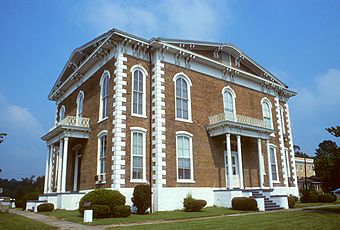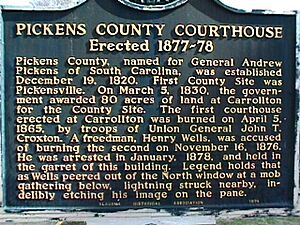Pickens County Courthouse (Alabama) facts for kids
|
Pickens County Courthouse
|
|
 |
|
| Location | Carrollton, Alabama |
|---|---|
| Built | 1877 |
| Architectural style | Italianate |
| NRHP reference No. | 94000441 |
Quick facts for kids Significant dates |
|
| Added to NRHP | May 19, 1994 |
The Pickens County Courthouse is a historic building in Carrollton, Alabama. It serves as the main courthouse for Pickens County, Alabama. Built between 1877 and 1878, it was the third courthouse in the city. This building is famous for a mysterious image that some people believe is a ghostly face. This image can be seen in one of its upper windows.
Many people say the face belongs to Henry Wells, a formerly enslaved person, from 1878. The story claims Wells was arrested in January 1878. He was suspected of setting fire to the previous courthouse. However, historical records show that the windows of the new courthouse were not even installed until after Wells had died. This means the story of his face appearing in the window at that moment is not historically accurate.
This time period was difficult in the South. The federal government had ended a period called Reconstruction in 1877. During Reconstruction, federal troops were in the South to help protect the rights of African Americans. After the troops left, some white leaders tried to regain control. They passed laws that made it harder for African Americans to have equal rights.
Contents
The Story of Henry Wells
The popular story about Henry Wells' face in the window is a mix of different historical events. It combines the story of a white man named Nathaniel Pierce and an African American man named Henry Wells.
This time was very confusing. The federal government was pulling its soldiers out of the Southern states. This officially ended the Reconstruction period. White leaders in the state government were taking back power. In many towns, white groups used violence to control African Americans. As time went on, more and more African American men were killed by angry mobs.
Nathaniel Pierce's Story
According to the local newspaper, the West Alabamian, Nathaniel Pierce was in jail. He was accused of a serious crime. On September 26, 1877, an armed group forced their way into the jail. They took Pierce outside the city and killed him. The newspaper did not say this event had anything to do with the courthouse burning.
Henry Wells' Arrest
Local white people already suspected Henry Wells and another man, Bill Buckhalter, of burning the courthouse. A newspaper story from December 13, 1876, said Wells and Buckhalter were also suspected of robbing a store. This robbery happened the same night the courthouse burned. Stolen items from the store were found in their homes. This linked them to the robbery, but not necessarily to the fire.
Buckhalter was arrested in January 1878. He admitted to the robbery. He also claimed that Wells was responsible for burning the courthouse. Wells was caught a few days later. When police found him, he tried to run away and was shot twice. He later admitted to burning the courthouse. It is believed he was forced to confess, possibly through beatings. He died from his injuries five days later.
These two separate events seem to have been combined into the popular myth. However, neither Pierce nor Wells could have been the "face in the window." Both men died before the windows were put into the new courthouse. The West Alabamian newspaper reported that windows were being installed on February 20, 1878. These were the main courtroom windows. The upper windows, where the ghostly face is seen, were installed weeks after Wells' death.
The Myth of the Face in the Window
Here is the commonly told myth about how the face appeared in the window.
On November 16, 1876, the people of Carrollton, Alabama, watched their courthouse burn. This building was very important to them. Their first courthouse had been burned by Union Army troops during the American Civil War. After the war, during Reconstruction, it was hard to rebuild. Money and materials were scarce. But the town worked hard and rebuilt the courthouse. It stood as a sign of their strength.
Less than twelve years after the first courthouse burned, the new one caught fire in 1876. Some said it was a robbery that went wrong. Even as work started on a third courthouse, the town wanted revenge for the fire. They suspected Henry Wells, a formerly enslaved person who lived nearby. There was not much clear evidence against him.
People said Henry Wells had a bad temper. They also said he carried a sharp knife and was not afraid to use it. But despite these rumors, there was only vague evidence linking him to the courthouse fire.
However, this was Alabama in 1878. Henry Wells was a black man accused of burning a symbol of the town's pride. He was arrested and charged with several crimes. He was taken to the sheriff's office inside the newly finished courthouse.
As news of Wells' arrest spread, the sheriff felt trouble was coming. When a few angry men started heading toward the courthouse, the sheriff took Wells to an upper room. He told Wells to stay quiet. But as the angry crowd gathered below, Wells became scared. He went to the window and looked down. He shouted, "I am innocent. If you kill me, I am going to haunt you for the rest of your lives!" Just then, a bolt of lightning struck nearby. The flash showed Wells' face, twisted with fear, to the crowd below.
The angry crowd forced their way into the courthouse. They took Wells outside, even as he kept saying he was innocent.
Early the next morning, a member of the crowd walked by the courthouse. He looked up at the upper window. He was shocked to see Wells' face looking down at him. It looked just as it had the night before. He rubbed his eyes, but the face was still there. He screamed, and others came. They all remembered Wells' warning: "If you kill me, I am going to haunt you for the rest of your lives!"
The face is said to remain in the courthouse window to this day. No amount of cleaning has been able to remove it. It is even said that once, a severe hailstorm broke every window pane in the courthouse, except for the one with Wells' face.
The Image on the Window Today
The image on the window is easy to see. It looks more like a face from some angles than from others. People say the image is only visible from outside the courthouse. From inside, the glass looks like a normal window pane.
In 1974, the Alabama Historical Association put up a special sign. This sign tells the story of the courthouse and the myth of Henry Wells' face in the window.
The city of Carrollton has even installed a reflective highway sign. It has an arrow pointing to the window where the image appears. There are also permanent binoculars across the street. Visitors can use them to get a closer look at the mysterious face.
In 2001, there were plans to tear down the courthouse. People wanted to replace it with a new building. The window with the face was covered with a piece of wood. Someone spray-painted a smiley face on it. But many people wanted to save the old courthouse and the image. Because of their efforts, the courthouse is now being repaired as money becomes available.
Understanding the Story's History
This legend is connected to the difficult history of racism in Alabama. This includes a time after the Reconstruction Era. During this period, many African Americans were killed by angry mobs. According to a 2015 study, Pickens County had 15 such killings after Reconstruction. This was the fifth-highest number in the state.
One terrible event happened on September 14, 1893. A white mob attacked the county jail in Carrollton. They shot and killed five African Americans in their cells. These people were Paul Archer, Will Archer, Emma Fair, Ed Guyton, and Paul Hill. They had been arrested for burning a white man's mill. They were killed without a trial. Two weeks before that, another man, Joe Floyd, was also killed in Carrollton without a trial.
John Harding Curry, who worked as a judge in the courthouse, worried about the window. During the civil rights protests of the late 1960s and early 1970s, he was concerned. He thought someone might damage the window. It could be seen as a symbol of a very unfair time. However, even though there was some race-related damage in town, the window was never touched.
Another judge once shared the Wells story with a group of fifth-grade students. They were from a black school in Birmingham. He had never told the story to a black audience before. He ended his tale with a lesson. "You might ask what that face in the courthouse is saying," he told the students. "It says to me, 'Don't ever let this happen again!'" He asked if they had questions. One little boy raised his hand and asked, "How do you know that's a black man up there?"
The Story in Books and Plays
Versions of this story were passed down through generations. Later, in the 1900s, the myth was included in books of ghost stories. These books were often written by white authors. Over more than 80 years, different events had been combined into one myth.
Henry Wells' story was in Kathryn Tucker Windham's book, 13 Alabama Ghosts and Jeffrey (1969). It also appeared in Ghost Stories from the American South (1985). Another book, Phantom Army of the Civil War and Other Southern Ghost Stories (1997), also included it.
In Patricia McKissack's book, The Dark-Thirty: Southern Tales of the Supernatural, a story called "Justice" has similar images on windows. It also includes a killing in its plot. However, the reasons and details of the crime are very different from the Wells myth.
In 2009, a bank asked a writer named Barry Bradford to create a play. The play was about the myth of Henry Wells, the burning of the second courthouse, and the window image. Since April 2010, his play, The Face in the Courthouse Window, has been performed every spring. It is even performed in the courtroom of the courthouse itself. All the money from the play helps to preserve the historic courthouse.
|


